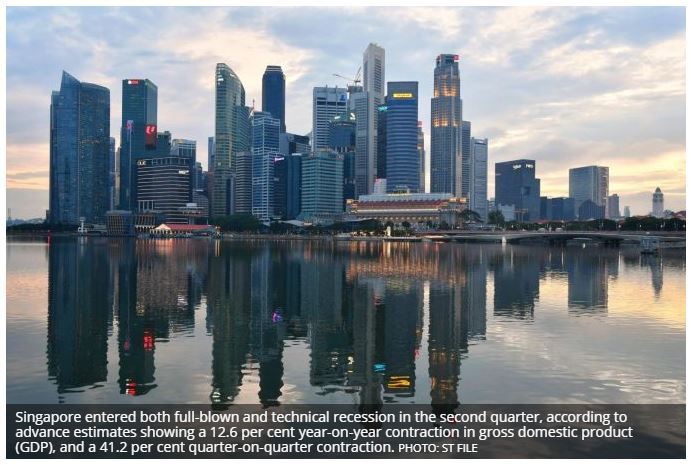Quick takes: Despite Singapore’s Q2 entry into recession, MAS may keep policy unchanged
SINGAPORE entered both full-blown and technical recession in the second quarter, according to advance estimates showing a 12.6 per cent year-on-year contraction in gross domestic product (GDP), and a 41.2 per cent quarter-on-quarter contraction.
The year-on-year figure was worse than economists’ expectations of a 10.5 per cent fall, and much worse than the first quarter’s 0.3 per cent contraction. “Circuit-breaker” measures implemented from April 7 to June 1 took a toll, as did continued weak external demand amid a global downturn.
Here are some quick takes from economists on the Q2 figures:
DailyFX – strategist Margaret Yang
“Singapore’s Q2 GDP figures disappointed markets. … The introduction of ‘circuit-breaker’ measures helped to contain the virus spread at the expense of temporary economic pain. This could have some negative impact on local stock markets this week.”
Barclays – economist Brian Tan
“Having flagged downside risks to our projections, we now expect GDP to fall by 5.5 per cent in 2020, compared with our previous forecast of a 4.5 per cent contraction. … While the Q2 GDP contraction was not as severe as we expected, pharmaceuticals production – which had initially seemed to benefit from the Covid-19 outbreak – has also faltered, leaving less of a cushion for headline GDP than we had projected earlier.”
“That said, our base case remains for the Monetary Authority of Singapore (MAS) to leave its FX policy settings unchanged in October. The MAS appears to view fiscal policy as being notably more effective at addressing the economic effects of the Covid-19 outbreak and the ‘circuit breaker’ compared to FX policy.”
Mizuho Bank – head of economics and strategy, Asia and Oceania treasury department, Vishnu Varathan
“Crucially, even with a widely expected bottoming in Q2, the worry is about a long, hard slog back, with the path to recovery littered with uncertainty. … The sharp fall in economic growth driven by a 13.6 per cent year-on-year drop in services and exacerbated by 54.7 per cent collapse in construction, overwhelmed modest 2.5 per cent gain in manufacturing. Which makes this an atypical and unprecedented downturn, as all past downturns were led by a collapse in manufacturing, are more often than not partly offset by the services sector.”
“And so, this is a sobering reminder that restoration of growth may be dictated by unfamiliar dynamics that are frustratingly reliant on both external demand – dampened by a prolonged infection cycle in the US/second-wave risks – as well as sub-par domestic demand recovery that is hampered by ‘new norms’ of stricter distancing and containment.”
“A knee-jerk ramp-up on policy stimulus is not our base case, despite how grim the data appear. Not only because Q2 data are backward-looking, and likely a bottom. More importantly, the four fiscal packages (~19 per cent of GDP) are working through. And monetary stimulus may not be the best response amid global demand collapse, but instead a last resort for asset market shocks.”
Nomura – economists Euben Paracuelles and Charnon Boonnuch
“We maintain our 2020 GDP growth forecast of -5.6 per cent… Our forecast implies a gradual recovery to only -9.0 per cent year-on-year in Q3 before an improvement to -0.4 per cent in Q4. This reflects our view that external demand remains weak and travel and tourism are still largely restricted, posing a drag to the recovery in services sectors. Despite the economic reopening, mobility data after the ‘circuit-breaker’ period also remain well below the pre-Covid-19 period. Due to the significant impact of the outbreak and disruption from the ‘circuit breaker’, we also expect the unemployment rate to worsen sharply to 4.5 per cent in H2 from 2.4 per cent in Q1.”
Maybank Kim Eng – economists Chua Hak Bin and Lee Ju Ye
“We expect smaller year-on-year GDP contractions in Q3 (-7 per cent) and Q4 (-4 per cent). Recovery in the second half will be dampened by the slow reopening, border controls, strict social distancing rules and foreign worker shortages. Phase Two of the reopening has started on June 19, but mobility has yet to fully normalise.”
“We raise our 2021 GDP forecast to +4 per cent (from +3.5 per cent) as activities normalise and the economy recovers from the worst phase of the pandemic in Q2 2020. We are projecting a U-shaped recovery and GDP returning to pre-pandemic levels only in 2022. We expect the MAS to maintain its neutral bias (zero appreciation of the S$NEER) at the October meeting.”
Source: https://www.businesstimes.com.sg/government-economy/quick-takes-despite-singapores-q2-entry-into-recession-mas-may-keep-policy


 English
English




